Mallika Naguran meets Ned Deloach, the co-author of Reef Creature Identification, Tropical Pacific, and his wife Anna at the launch of the guidebook in Singapore. And gets hooked by
amazing discussions on marine diversity, natural selection and critter hunting.
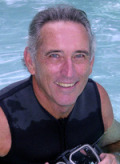
Ned Deloach loves cryptic critters.
Singapore, 30 October 2010. Ned and Anna Deloach could barely contain their excitement when describing to Mallika Naguran (in a Gaia Discovery exclusive interview) their experiences in hunting, photographing and documenting invertebrates - marine animals without backbones - for the all-new Reef Creature Identification, Tropical Pacific.
The range of mobile marine invertebrates they describe can be found in the warm tropical waters of the Pacific Ocean, ranging from Thailand to Tahiti.
Co-authored by Ned Deloach and Paul Humann, the book was first released in Singapore, Asia late October followed by a release in the US in November. The two well-known marine life naturalists, writers and photographers have authored eight other field guides and other productions over 20 years.
This 500-page reference brings to the fore some 1,600 mobile marine invertebrates with 2,000 photographs contributed by various divers (including Asians William Tan, Ivan Choong, Indra Swari, Stephen Wong, Takako Uno and Ria Tan) in a visually pleasing layout. The text incorporates taxonomic research by 40 scientific specialists, yet is descriptive enough to be easily understood by jargon-averse readers.
“The book breaks away from the scientific context and brings information to the lay people,” said Ned. “I'm sure they will be startled to see the immense population and diversity of such invertebrates.”

Simpson's Snapping Shrimp. Pic by Ned Deloach.
Ned, based in Jacksonville, Florida, was an educator and has worked extensively as a journalist and photographer for various publications. He has been diving for “just more than 40 years” since he left college in his 20s.
Anna has been a trusty partner in the making of this book by scouting the subjects. She shoots videos and films for documentaries and co-produced Sensational Seas, an anthology of rare underwater images in 2004.
Anna says the reef creature guide is not just for dive junkies, but also for everyone. “What’s groundbreaking about this book is not just the sheer numbers but the number of animals that scientists have not seen. The critters appeal even to non-divers who will be amazed to see that such creatures actually exist.”
The beauty and diversity of marine creatures including many undescribed species unfold before your eyes as you turn the chapters of this guide that even display animals up to three quarters of the page even.
“Even though this is a guide, we wanted to honour the animals by enlarging their images,” explained Anna.
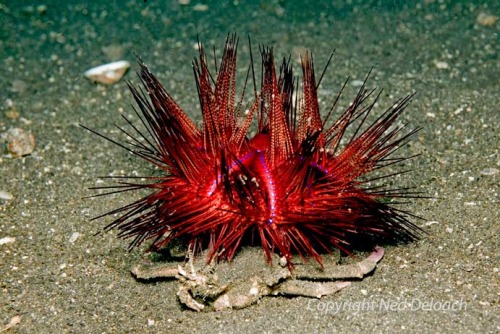
Urchin carrying crab. Dorippe-fascone. Pic by Ned Deloach.
The content begins with the simplest multicellular form and progresses on to more complex biological components. Four phyla are covered: crustaceans, molluscs, worms and echinoderms.
Upfront, the book also describes and illustrates stony, soft and black corals, gorgonians, anemones, corallimorphs, sponges, hydroids, jellyfishes, ctenophores and tunicates but does not provide detailed species description of each. Rather it focuses on free-swimming and crawling marine animals without backbones. Yes, nearly 2000 photographs just on those.
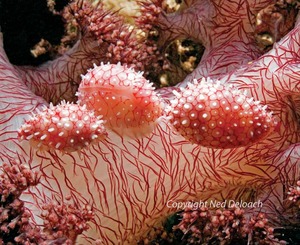
Wilson's Egg Cowrie, Prionovula-wilsoniana. Pic by Ned Deloach.
You can learn how to tell the devious Wunderpus apart from the Mimic Octopus, and at the back of the book explore the world of symbiosis relationships, the wonders of invertebrate reproduction and other wondrous behavioural traits.
It took the team five years to put together this massive collection, documenting them, getting scientists to describe them and for peer review. “The new book represents our most pioneering work,” DeLoach explained. “Although quite detailed, what we have compiled only scratches the surface of the undreamed-of animals still out there waiting to be discovered.”
The Wild, Wild New Thanks to Natural Selection
I am not a big fan of nudibranchs. I kind of like the big stuff. The bigger, the better.
Flipping through the pages of this guide, however, I come across a slug barely longer than my pinky finger illuminated with Xray-like effects and ghostly branch tips. The Bolland’s Tritonia, states the picture caption, is a deep-water species that can be found in the West Pacific.
And across the page is a translucent white slug with red-orange-brown glow - the wildest creature I’ve ever seen! It is an undescribed species of Dendronotid Nudibranchs – Tritoniidae. Neither species mentioned fit into your everyday image of a nudibranch, and that’s because nature has woven its magic over time to change the physical characteristics of the creature according to environmental and biological factors. Now that caught my attention.
“Lacking the constraints of vertebrae, natural selection for these special groups of animals has gone wild,” said Ned. “We marvel at evolution through natural selection. It alters the animals so that they can survive and feed and these other habitats without so many hiding holes.”
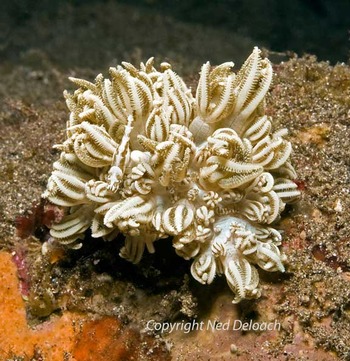
Xenia-like nudibranch carrying a commensal shrimp. Pic by Ned Deloach
Ned described how in Flores in April 2009, at just 2m deep at Mucky Mask, he chanced upon a shrimp that mimicked a hard seashell until its blue eyes gave it away. He also spotted an undescribed Aeolid nudibranch that had what seemed like pulsating Xenia soft corals on its body (see photo).
“Wallace, Darwin and Hooker and the people of their time went out and brought back all those great specimens - they got Europe alive with excitement. I wouldn’t compare myself to those greats but in this age of digital photography, by recording these animals underwater, I think our message to protect these animals will be heard” said Ned.
Ned, also a fan of decorator crabs, is keen they should get more documentation about their natural selection. “This spider crab group with velvet-like hooks all over their body clip stationary animals off the reef and hook them on their backs. This disguises their presence – not just from predators but from the inquisitive eyes of divers too. This makes the game of cryptic animal hunting even more exciting,” he chuckled.
“You have virtually got to look at everything. You do not know if they are animal- that’s their intent. Natural selection allows them to live and proliferate in these varied environments.”
At the interview, photographer Ivan Choong shared how he chanced upon the rare Teddy Bear crab in Manado house reef. He remembered how in the heat of the moment, he screamed through his regulator.
"Look at this excitement!” laughed Ned. “We love it when people have a passion for natural history.” It turned out that Ned had never seen that crab species (Poludectus cupulifer) before and I saw his eyes sparkle. Even though you'd think he would have had enough of turning over “10 cadgillion rocks” in search of cryptic animals - well apparently not!
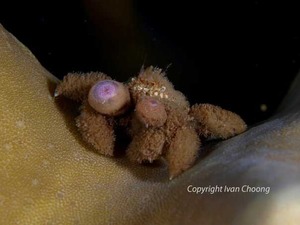
Teddy Bear crab, Polydectus cupulifer. Pic by Ivan Choong.
“There are many things I have yet to see. I don’t care how many rocks we have to turn over. There’s always a creepy crawly to be discovered,” said Ned, who sticks his nose into rubble, coral fragments, sea grass meadow, and of course muck on a regular basis.
Photographers’ Role in Protecting the Oceans
Sadly, Ned and Anna have also witnessed degradation of habitats due to destructive fishing practices. This results in biomass loss in some parts, evident in especially far eastern Indonesia.
“We (humans) keep pushing and pushing the environment and the oceans; maybe this book will be one small step in the endeavour to protect it,” said Ned. “I hope that this might give people some ideas on what there is underwater that they could protect.”
He explained how everybody can support this initiative by capturing and recording amazing new finds when scuba diving. “The role of photographers is very important in documenting natural history… they can send the photos to the Reef Environmental Education Foundation (REEF) that I started with Paul Humann in 1990,” said Ned.
REEF promotes understanding of marine populations through a volunteer fish monitoring program and surveys. “We have thousands of photos posted by recreational divers since and data from 140,000 marine surveys on the site,” explained Ned. Anyone can use the data. Divers and non-divers alike can become members of this marine conservation program, so do sign up.
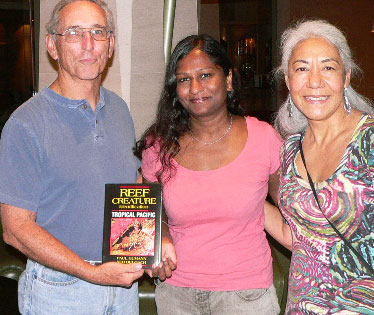
Writer (middle) is now a macro convert, thanks to Ned and Anna Deloach.
This book's objective is pretty clear. Reef Creature Identification, Tropical Pacific is designed to show the beauty of ocean creatures, many of which have never been seen before, with the hope that they will be treasured. Many more have yet to be discovered even in the shallows.
“We are the first generation to see these underwater,” said Ned. “We hope that the book will be a worthy ambassador of the natural history of the marine critters that we so love.”
I was delighted to receive a press copy of the book, in which Ned signed “Dear Mallika, I hope you find every critter in this book!”
You betcha.
Photographs courtesy of Ned Deloach and Ivan Choong.
Reef Creature Identification– Tropical Pacific is available in Asia through DiveBooks.Net (www.divebooks.net) at SGD75 and elsewhere at New World Publications(www.fishid.com) at USD48. Shipping charges apply.
With thanks to Ivan Choong for facilitating the interview.

